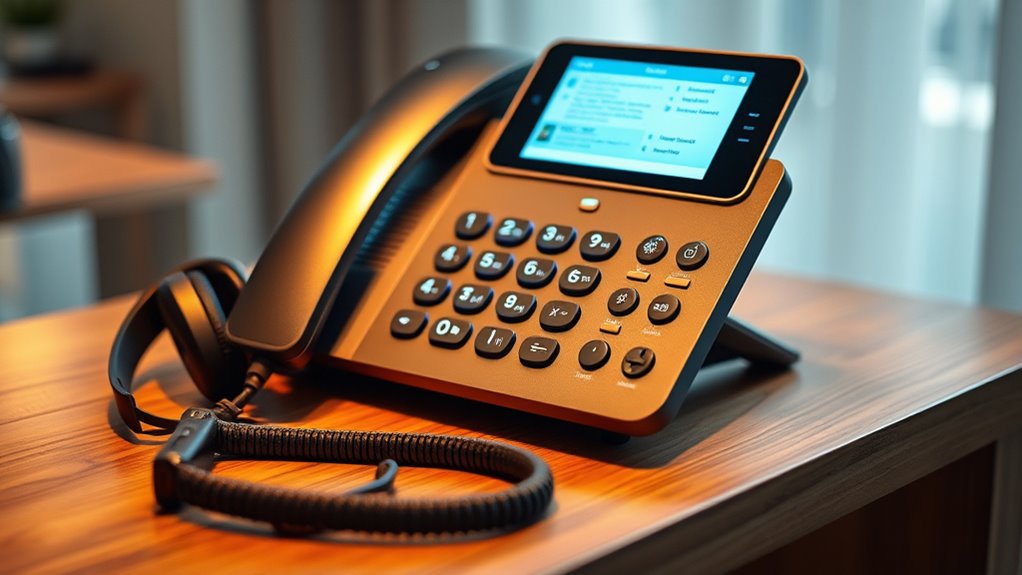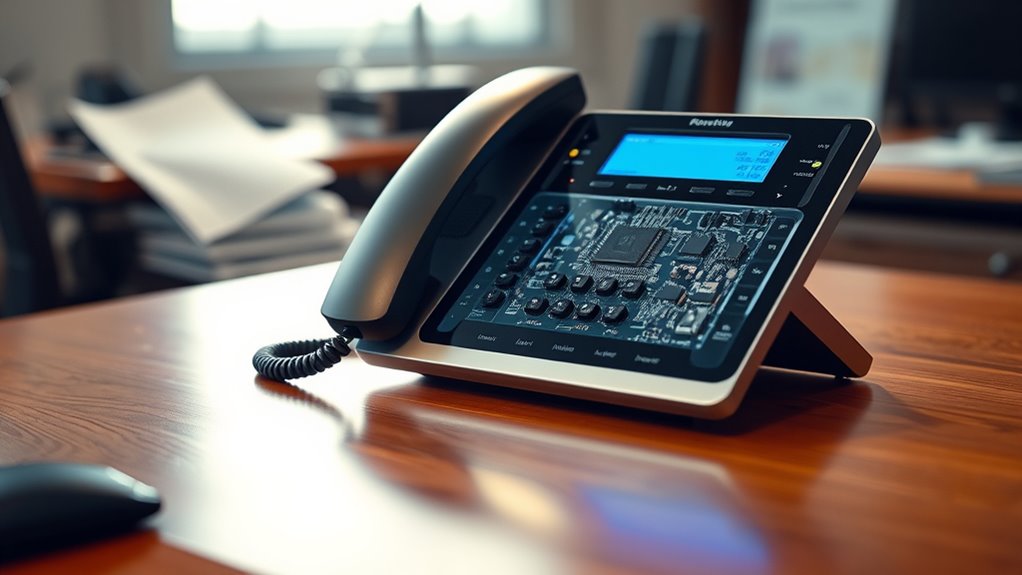Captioned telephones use real-time speech recognition to turn spoken words into text during calls. As you speak, the device captures your voice with a microphone, filters out background noise, and processes the audio with advanced recognition software. The software instantly transcribes the speech into captions displayed on a screen, helping you understand conversations clearly. Behind the scenes, continuous improvements and internet connectivity enhance accuracy. If you want to discover more about this innovative technology, keep exploring how it works.
Key Takeaways
- Convert spoken words into text instantly using real-time speech recognition software during calls.
- Process and filter incoming audio to focus on the speaker and reduce background noise.
- Display live captions on an integrated screen, enhancing comprehension for users with hearing impairments.
- Connect to cloud-based services for continuous updates and improved transcription accuracy over time.
- Incorporate user-friendly features like adjustable fonts and visual indicators to optimize the call experience.

Have you ever struggled to hear or understand phone conversations clearly? If so, captioned telephones might be just what you need. These devices are a prime example of assistive technology designed to improve the user experience for people with hearing impairments. But how do they work behind the scenes? Understanding the technology can help you appreciate how much easier these phones make communication.
Captioned telephones use real-time speech recognition technology to convert spoken words into text for clearer communication.
When you pick up a captioned telephone, you’re not just hearing the caller’s voice through a speaker. Instead, the device captures the audio and converts it into text in real time. This process relies on advanced speech recognition software that transcribes spoken words into written captions almost instantly. The captions appear on a screen integrated into the phone, allowing you to read what the caller is saying while simultaneously hearing their voice. This dual approach helps ensure you don’t miss important details, making conversations clearer and more accessible.
Behind the scenes, the core component of a captioned telephone is its speech-to-text engine. This system processes the incoming audio signal, filtering out background noise and focusing on the speaker’s voice. It then sends the cleaned audio to the speech recognition software, which transcribes it into text. The accuracy of this process depends heavily on the quality of the microphone, the sophistication of the speech recognition algorithms, and the clarity of the speaker’s voice. Developers continually refine these systems to improve transcription accuracy, especially in noisy environments or with speakers with different accents.
The user experience is central to how well captioned phones work for you. A well-designed device offers intuitive controls, adjustable font sizes, and customizable display options so you can tailor the experience to your needs. The captions are displayed in real time, and many devices also include features like highlighting the current speaker’s words or providing a visual indicator of incoming calls. These features reduce frustration and make conversations feel more natural.
Furthermore, modern captioned telephones often connect to internet-based services, enabling cloud-based speech recognition that benefits from ongoing updates and improvements. This connectivity ensures that the device can adapt to new speech patterns and vocabulary, enhancing transcription accuracy over time. Additionally, some systems incorporate advanced audio processing to better distinguish speech from background noise, further improving clarity. Overall, the seamless integration of assistive technology and user-centered design transforms how people with hearing challenges communicate, making phone conversations more inclusive and less stressful. Thanks to these behind-the-scenes innovations, you’ll find that staying connected becomes much easier and more natural.
Frequently Asked Questions
How Is Real-Time Captioning Accuracy Maintained During Calls?
You might wonder how real-time captioning stays accurate during calls. Speech recognition technology processes your speech instantly, converting it into text with high precision. To guarantee data security, these systems use encryption and strict privacy protocols, protecting your conversations. Continuous updates and machine learning improve accuracy over time, adapting to your speech patterns. So, while you communicate, the system works behind the scenes, maintaining accuracy and security seamlessly.
What Are the Privacy Considerations for Captioned Telephony?
You might think privacy concerns are minimal with captioned telephony, but they’re actually important. Data encryption protects your conversations from unauthorized access, ensuring your privacy stays intact. However, be aware that some captioning services may store or transmit your data to improve accuracy, so always check their privacy policies. Understanding these measures helps you trust the system while safeguarding your sensitive information during calls.
How Do Captioned Phones Differ From Traditional Hearing Aids?
You’ll notice visual differences between captioned phones and traditional hearing aids, as captioned phones display text of conversations on a screen, while hearing aids amplify sound. The cost comparison also varies; captioned phones tend to be more affordable and provide visual access, whereas hearing aids involve higher expenses but offer sound amplification directly. While they serve different needs, both improve communication, especially for those with hearing impairments.
Can Captioned Telephones Be Used Internationally?
You might wonder if captioned telephones work internationally, and the answer depends on several factors. International compatibility is limited because these phones often rely on specific networks and technology. Additionally, voltage considerations are vital; you’ll need to check if the device supports different electrical standards. To use a captioned telephone abroad, make sure it’s compatible with local systems and voltage requirements, or you may need adapters or converters.
What Technical Skills Are Needed to Set up Captioned Phones?
To set up captioned phones, you need basic technical skills related to installation procedures and hardware configuration. You should understand how to connect the device properly, guarantee the necessary software is installed, and configure settings for ideal captioning performance. Familiarity with troubleshooting common hardware issues and following manufacturer instructions helps guarantee the captioned phone functions correctly. With these skills, you can confidently set up and maintain captioned telephones for effective communication.
Conclusion
Now that you know how captioned telephones work behind the scenes, you can appreciate their clever technology helping you communicate with ease. Think of it as having a trusty, modern messenger at your side—no need for a carrier pigeon! With real-time captioning, you stay connected and informed, even in noisy environments. So, next time you pick up the phone, remember—this isn’t just some fancy gadget; it’s a lifeline, bridging gaps faster than you can say “Eureka!”











